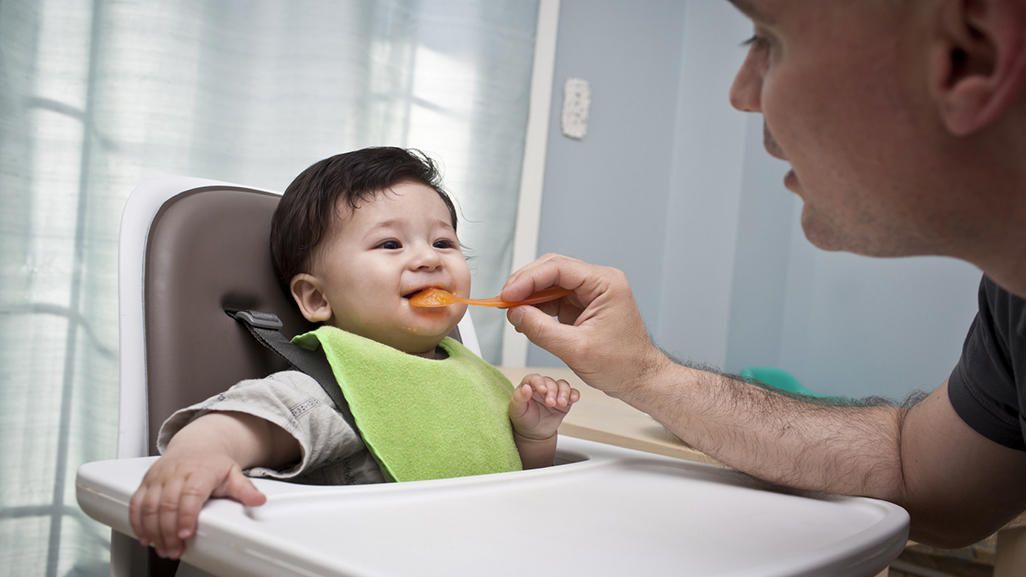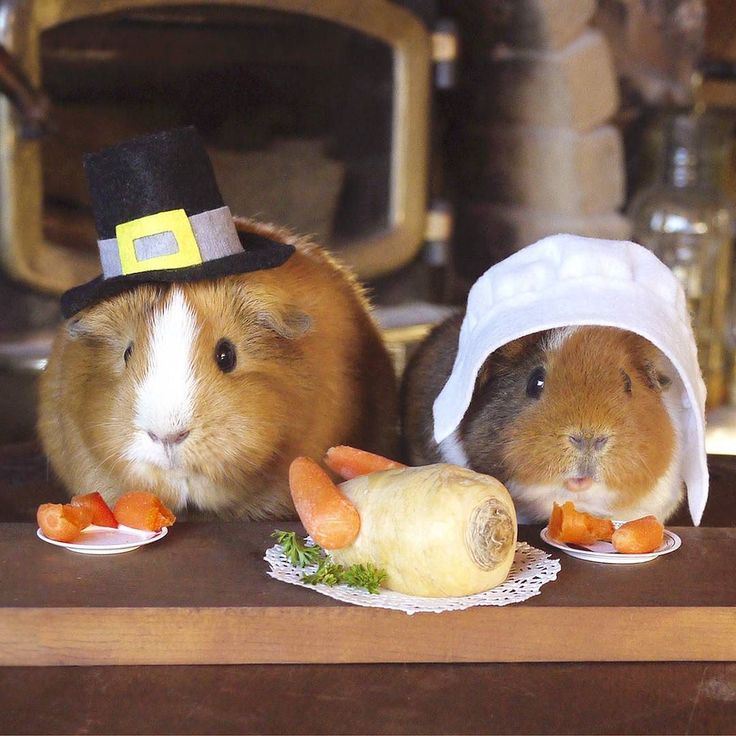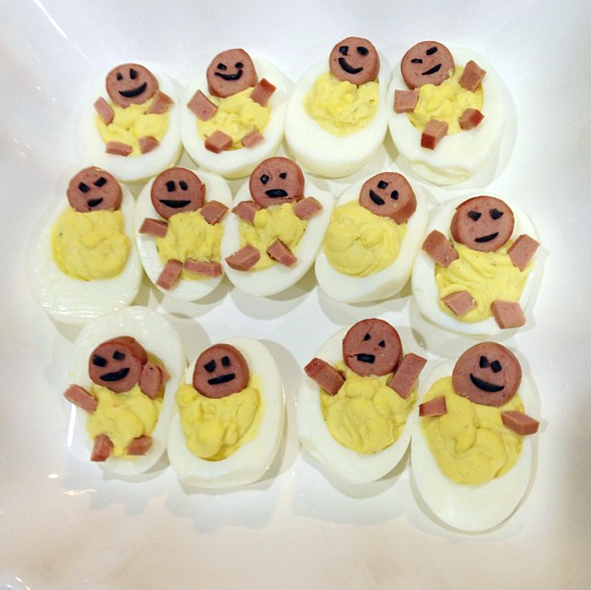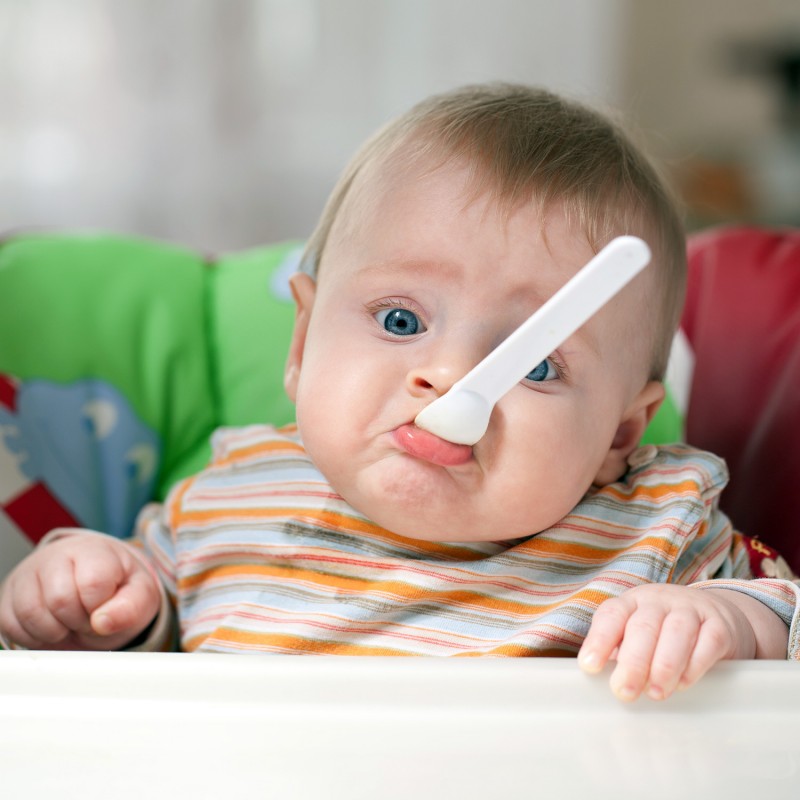How often should you feed a baby raccoon
What Do Baby Raccoons Eat?
So you finally have your pet raccoon. You are now ready to start your adventure of raising a baby raccoon. So as you arrive home with your new pet, eager to take care of him, this is the first question you need to answer: What do baby raccoons eat?
If you wanted a head start on your relationship, you probably bought a raccoon that is still on the bottle, which means a very young raccoon. Purchasing a raccoon that is still on the bottle is necessary for the bonding process. But taking care of these critters is in itself a challenging and demanding task. You need to establish a friendly relationship with the animal from an early age. Such an approach will prove beneficial in the long run and you will experience fewer problems with your pet.
What To Feed Baby RaccoonsThis is your first encounter with the demanding task of having a pet raccoon. The question, “what do baby raccoons eat”, is quite simple: powdered milk with high fat content. Just keep in mind this important information — never feed your little raccoon whole milk.
If the food your new pet requires is quite simple, the how and when of feeding are a different story.
For about the first seven weeks of life, you need to feed the baby raccoon up to five times a day. To feed him at regular intervals, you will even need to wake up during the night and respond to his pleas for food.
How much food do baby raccoons eat? While they are nursing, they may easily overfeed. You must give your raccoon just enough to feel that his belly is full. Do not wait until he starts to refuse the milk because this is a sign that he has already had too much.
After each feeding you should burp the raccoon, and at the same time, using a cotton ball soaked in warm water, massage the genital area to help him relieve himself.
The first few weeks will definitely be an amazingly busy time for you and your new pet raccoon. But after the first few weeks, the baby raccoon will be ready to get into some solid foods.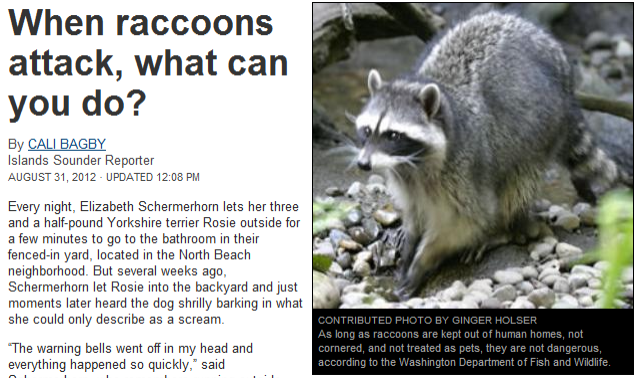
Weaning a raccoon is not difficult, though some individuals may be harder to bottle-break than others.
When you see that your pet is big enough, usually around the seventh or eighth week, you can start to introduce some of the foods raccoons will eat as an adult.
After the bottle, your raccoon will begin to show his omnivorous side, and he can start to eat almost any kind of food. Even so, you should introduce the food gradually. You might, for instance, add baby cereal to the milk or give him a soft food like fruit that he is able to chew.
What Do Baby Raccoons Eat After WeaningAfter your baby raccoon has been weaned, the task of feeding the animal will still be demanding. It may be easier than bottle-feeding, but controlling your pet’s diet will always be your responsibility.
Raccoons living in the wild can eat practically anything, and their diets are pretty variable. The wild raccoon diet depends on the animal’s personal instincts and the different seasons and habitats he is dealing with. In contrast, a pet raccoon cannot make his own decisions about food. He is completely dependent on you.
The wild raccoon diet depends on the animal’s personal instincts and the different seasons and habitats he is dealing with. In contrast, a pet raccoon cannot make his own decisions about food. He is completely dependent on you.
You cannot treat your raccoon like a dog or a cat; it is not that simple. These common pets can survive on canned food, but not your pet raccoon. He may love cat or dog food in the can, but feeding him only that is not healthy for the animal. Make sure to give your pet a variety of food items daily and to choose the healthiest ones.
The Gable's Raccoon Rehab Info & Tips
The Gable's Raccoon Rehab Info & Tips| Main/Home | What's New | Search Site | Raccoon Tales |
| Pictures & Graphics | Raccoon Facts & Info | Raccoon Problems | Diseases & Parasites |
| Raccoon Fun Pages | Causes & Links | Awards & Rings | Contact & Feedback |
| |
 Everyone reading this should first be familiar with rabies, the raccoon rabies varient, and the precautions needed to prevent exposure to a possibly infected raccoon. If you have not done so yet, you are urged to read the information contained in my RABIES page. Everyone reading this should first be familiar with rabies, the raccoon rabies varient, and the precautions needed to prevent exposure to a possibly infected raccoon. If you have not done so yet, you are urged to read the information contained in my RABIES page. |
- Age determination
- Feeding baby raccoons
- Feeding juvenile raccoons
- Potty training raccoons/raccoon roundworm
- Housing young raccoons
- Housing juvenile raccoons
- Dealing with imprinting and other problems
- Preparing a raccoon for release
Age Determination
Raccoon kits or cubs (whichever term you prefer, since it seems nobody can agree on one) are born very lightly furred, with a faint mask. They typically weigh three to five ounces and 4-6 inches long with 2-2 1/4" tail. Pigmented tail rings will either be present or will appear at about one week of age. Their eyes are closed and so are their ears (ear are pressed tightly forward to the head. ) The head seems large in comparison to the rest of the body. When hungry, cold, or not in contact with another warm body, the babies will start chattering, whine or twitter like birds. They can crawl in a spider-like fashion with all four legs in extension, but cannot climb or stand and support their full weight. The eyes open at about two to three weeks, the ears shortly thereafter. They now average 7-10" long. They will be VERY vocal at this age. They will churr, growl, hiss, and give an alarm snort. By 4 weeks they are about 12-13" long. When five to six weeks old, most can walk, run, and climb very well. Seven-week-old babies will engage in active (and sometimes rough) fighting characterized by growling, squealing, biting, wrestling, and imitating adult defense postures. They remain in their birth den until they are about seven or eight weeks old, at which point their mother moves them to a series of alternate dens. After about eight to nine weeks of age they begin eating solid foods in the wild and by 10 weeks they are traveling with their mother.
) The head seems large in comparison to the rest of the body. When hungry, cold, or not in contact with another warm body, the babies will start chattering, whine or twitter like birds. They can crawl in a spider-like fashion with all four legs in extension, but cannot climb or stand and support their full weight. The eyes open at about two to three weeks, the ears shortly thereafter. They now average 7-10" long. They will be VERY vocal at this age. They will churr, growl, hiss, and give an alarm snort. By 4 weeks they are about 12-13" long. When five to six weeks old, most can walk, run, and climb very well. Seven-week-old babies will engage in active (and sometimes rough) fighting characterized by growling, squealing, biting, wrestling, and imitating adult defense postures. They remain in their birth den until they are about seven or eight weeks old, at which point their mother moves them to a series of alternate dens. After about eight to nine weeks of age they begin eating solid foods in the wild and by 10 weeks they are traveling with their mother. By four months old, they will be completely weaned and somewhat independent. Raccoon mothers with babies enjoy a privileged position in the raccoon hierarchy for as long as the babies remain with the mother. Other raccoons will defer to a female with babies in feeding situations. For rehabbers, the appropriate age for releasing hand-raised baby raccoons back into the wild is 16 to 24 weeks. This of course would be subject to the season of the year and the readiness of the animal. I prefer to wait until they are at least 20-24 weeks. At this age they are still young enough that there instincts take over and they become truly wild following their release.
By four months old, they will be completely weaned and somewhat independent. Raccoon mothers with babies enjoy a privileged position in the raccoon hierarchy for as long as the babies remain with the mother. Other raccoons will defer to a female with babies in feeding situations. For rehabbers, the appropriate age for releasing hand-raised baby raccoons back into the wild is 16 to 24 weeks. This of course would be subject to the season of the year and the readiness of the animal. I prefer to wait until they are at least 20-24 weeks. At this age they are still young enough that there instincts take over and they become truly wild following their release.
[top]
Feeding baby raccoons
DON'T GIVE THEM MILK! They should be on kitten milk replacement formula. (You can substitute baby formula or even condensed milk in an emergency only situtation but NEVER regular milk!) If they are dehydrated when you get them, feed a rehydrating formula for the first 2-3 feedings and ease slowly into regular formula.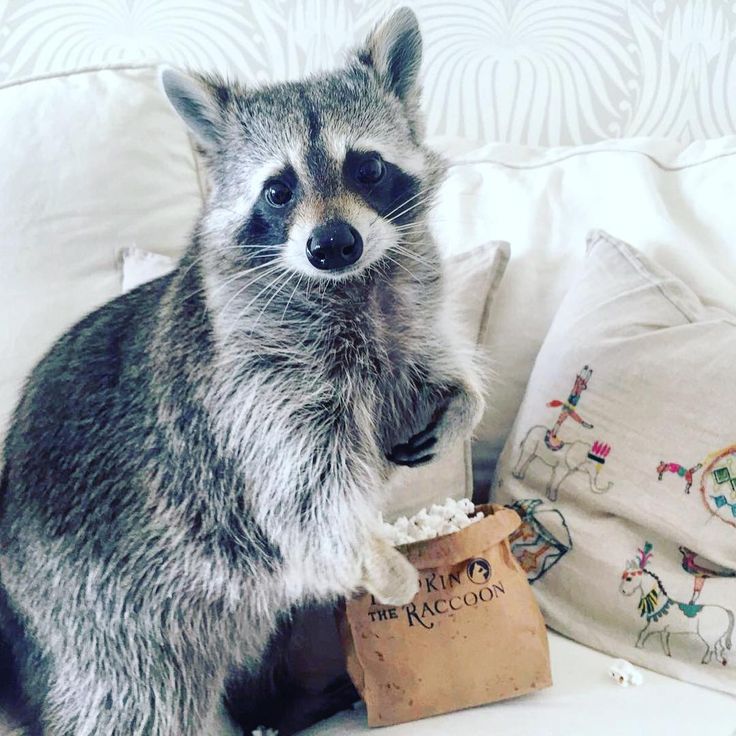 Formula should be heated to body temperature before feeding (100-102F). You should be feeding them 5 times a day (that includes in the middle of the night) for the first four weeks. Use an eyedropper (a bulb syringe really - you can pick it up at any vet's office or some pet stores) if they don't take to the bottle yet (animal nurser bottle, 4 ounce size, available at pet shop or a baby bottle with preemie nipple). Don't overfeed! Raccoons will overeat when nursing. If their little belly feels full, stop. It is better to feed more often than to overfeed.
Formula should be heated to body temperature before feeding (100-102F). You should be feeding them 5 times a day (that includes in the middle of the night) for the first four weeks. Use an eyedropper (a bulb syringe really - you can pick it up at any vet's office or some pet stores) if they don't take to the bottle yet (animal nurser bottle, 4 ounce size, available at pet shop or a baby bottle with preemie nipple). Don't overfeed! Raccoons will overeat when nursing. If their little belly feels full, stop. It is better to feed more often than to overfeed.
You should always feed them belly down, not on their backs. You may find that rubbing or scratching their necks helps to stimulate them to nurse. You may also have to burp them - just like you would a baby. You may have to manually stimulate them to eliminate for another few weeks. Use a cotton ball dipped in warm water, gently swap genital area from front to back.
At 4 weeks (about a week after their eyes open), they should probably be up to taking at least 2 ounces or more from a bottle - start adding some baby rice cereal into the formula, cut it down to 4 times a day. I like to use iron fortified baby rice cereal with banannas. At six weeks I usually start adding a small amount of canned kitten food in with the formula.
I like to use iron fortified baby rice cereal with banannas. At six weeks I usually start adding a small amount of canned kitten food in with the formula.
Baby raccoons will nurse for approximately 8 weeks and you can wean them off the bottle onto a gruel of formula, baby cereal, and canned kitten food (I prefer Little Friskies Turkey for kittens). Gradually work them up to dry dog kibble as the main staple, along with a variety of fruits, vegetables and any of nature's yummies and yuckies (minnows, etc.).
[top]
Feeding juvenile raccoons
Once they are fully weaned (approximately 8-10 weeks), you should gradually work up from a soft gruel to a high quality dry dog kibble as the main staple. To this, you can add whatever meals, snacks and treats you wish. What one raccoons loves another may turn his nose up at. Carrot lovers are rare. Most will devour uncooked corn on the cob (and have a ball shucking it themselves) but this is not advisable if you will be releasing them in an area near corn farms.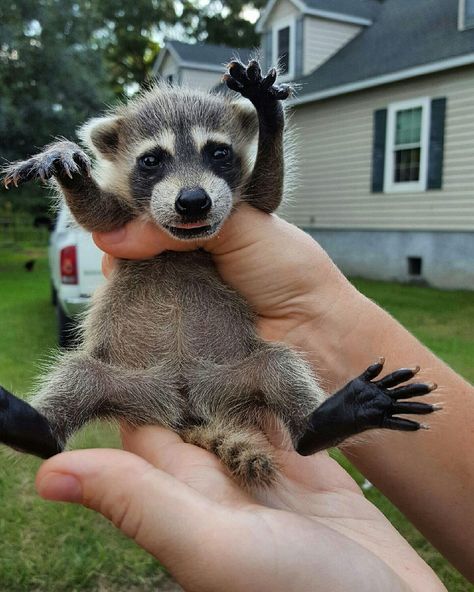 Same goes for watermelons. All my raccoons loved dog biscuits and grapes and they can be very useful as bribes. (You may have to initially cut the grapes in half until the raccoons discover what they are.) Raccoons have a sweet-tooth and, while I have never given mine any, I understand they love marshmallows. Use any sweets sparingly. I sometimes give them dry cat food for a change. I buy minnows and crickets at the bait shop and the raccoons enjoy fishing and hunting for them. This teaches them invaluable skills they will need in the wild. They also enjoy digging for grubs and other tidbits and the nuts and berries that our trees put forth. Basically, a raccoon will put ANYTHING it finds into its mouth. If it tastes good to him, he eats it.
Same goes for watermelons. All my raccoons loved dog biscuits and grapes and they can be very useful as bribes. (You may have to initially cut the grapes in half until the raccoons discover what they are.) Raccoons have a sweet-tooth and, while I have never given mine any, I understand they love marshmallows. Use any sweets sparingly. I sometimes give them dry cat food for a change. I buy minnows and crickets at the bait shop and the raccoons enjoy fishing and hunting for them. This teaches them invaluable skills they will need in the wild. They also enjoy digging for grubs and other tidbits and the nuts and berries that our trees put forth. Basically, a raccoon will put ANYTHING it finds into its mouth. If it tastes good to him, he eats it.
[top]
Potty training raccoons/raccoon roundworm
Once a raccoon can walk, he is old enough to start training him to a litter-box. If you use a water bowl instead of a water bottle, the raccoon will eliminate in the water bowl. He will then proceed to "wash" his food in that same water. Get rid of the water bowl. Place a litter box in the raccoon enclosure. If you are still in the weaning to solid food process, place a small tin with kitty litter next to the feeding area. If the raccoon starts to eliminate, immediately place him in the litter. This will help speed up the process and keep him from using his food bowl as a toilet. Raccoons will share a litterbox. Unlike cats, they do not bury their feces. And they think nothing of knocking the litter box over just for the fun of it. I weigh it down with a piece of concrete under the litter.
He will then proceed to "wash" his food in that same water. Get rid of the water bowl. Place a litter box in the raccoon enclosure. If you are still in the weaning to solid food process, place a small tin with kitty litter next to the feeding area. If the raccoon starts to eliminate, immediately place him in the litter. This will help speed up the process and keep him from using his food bowl as a toilet. Raccoons will share a litterbox. Unlike cats, they do not bury their feces. And they think nothing of knocking the litter box over just for the fun of it. I weigh it down with a piece of concrete under the litter.
Raccoons are the normal host for the parasitic roundworm known as Baylisascaris procyonis. This roundworm is zoonotic, meaning it can pass from animal to animal (or human). It can cause a very rare disease called visceral larva migrans in humans and other animals. The disease is spread through the eggs contained in the feces of an infected raccoon. If ingested by an abnormal host (an animal other than a raccoon), it undergoes an aberrant migration through the body. The eggs hatch, and the larvae migrate to the brain, eyes and other organs. This condition can cause death or paralysis depending on the location in the body and number of worms. Prevention consists of never touching or inhaling raccoon feces, using rubber gloves and a mask when cleaning cages (or attics, etc.) which have been occupied by raccoons, burying or burning all feces, keeping children and pets away from raccoon cages and enclosures, and disinfecting cages and enclosures between litters. All cages and nest boxes used for housing raccoons should not be used for any other animals. They should remain strictly for raccoon use. Do frequent fecal screens on all raccoons in your possession. If positive, your wildlife vet may recommend treatment with Panacur at .1 cc per pound of body weight each week until release. Remember that raccoons may have fecal matter on their paws and bodies and take appropriate safeguards. As a precaution, all my raccoons when taken into rehab receive de-worming under our vet's supervision.
The eggs hatch, and the larvae migrate to the brain, eyes and other organs. This condition can cause death or paralysis depending on the location in the body and number of worms. Prevention consists of never touching or inhaling raccoon feces, using rubber gloves and a mask when cleaning cages (or attics, etc.) which have been occupied by raccoons, burying or burning all feces, keeping children and pets away from raccoon cages and enclosures, and disinfecting cages and enclosures between litters. All cages and nest boxes used for housing raccoons should not be used for any other animals. They should remain strictly for raccoon use. Do frequent fecal screens on all raccoons in your possession. If positive, your wildlife vet may recommend treatment with Panacur at .1 cc per pound of body weight each week until release. Remember that raccoons may have fecal matter on their paws and bodies and take appropriate safeguards. As a precaution, all my raccoons when taken into rehab receive de-worming under our vet's supervision. For more in-depth information, please see my page on Raccoon Roundworm.
For more in-depth information, please see my page on Raccoon Roundworm.
[top]
Housing young raccoons
Make sure that they are warm enough. If necessary, a heating pad wrapped in towels (if your towels have loops use a pillowcase over them) may be used at this age but be careful. There is a non-electric heating pad marketed by SnuggleSoft that you just heat in the microwave for around four minutes and, slipped under the bedding, provides up to 12 hours of safe, gentle, warmth.
Newborn to five week old raccoons can be housed in a cardboard box or, better yet, a small animal carrier. It will be warmer for them and easier for you. Raccoons will curl together into one furry lump for sleeping. If your raccoon does not have littermates, provide a suitable stuffed toy as a substitute. As raccoons grow, so must their enclosure but always keep a bed (den) area in it. Cardboard boxes sized to the raccoons work well for the bed for young raccoons - line bottom with towels for warmth.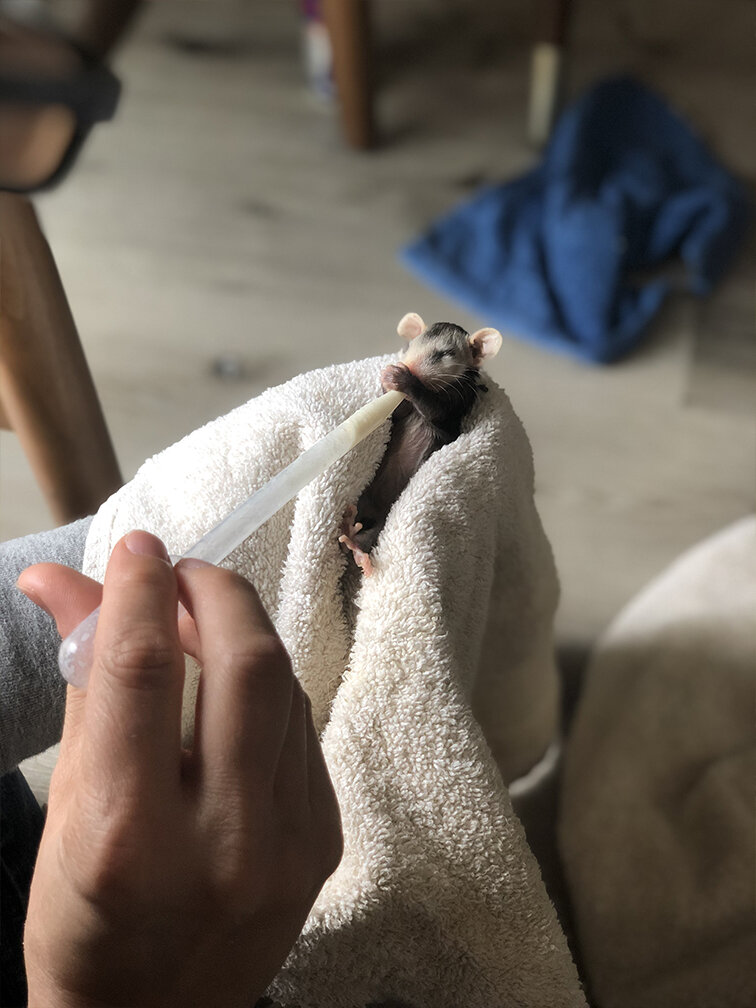 Juvenile raccoons will make short work of the cardbox box. At that age, I prefer to start using that small animal carrier as their bed. Depending upon the number of raccoons in the litter, you may need a small dog carrier. Remove the door from the carrier - (and any other removable pieces for that matter or the raccoons will do it for you) and place in in their enclosure. Clean and inspect the carrier daily. One advantage of using the carrier as their bed is that it makes it much easier when you must travel with the raccoons, either for vet visits or their final release into the wild. Since they feel secure in their "bed", car trips are a lot easier on everyone involved. Although I did have a litter once that "escaped" from the carrier while I was driving. Actually, it was a planned breakout - they couldn't push the door open but they managed to pull it in. I had to pull over to the side of the road while they had a ball exploring the car. Moral of story: to make sure they can't get the door open while you're travelling, tie it securely rather than just relying upon the built in locks.
Juvenile raccoons will make short work of the cardbox box. At that age, I prefer to start using that small animal carrier as their bed. Depending upon the number of raccoons in the litter, you may need a small dog carrier. Remove the door from the carrier - (and any other removable pieces for that matter or the raccoons will do it for you) and place in in their enclosure. Clean and inspect the carrier daily. One advantage of using the carrier as their bed is that it makes it much easier when you must travel with the raccoons, either for vet visits or their final release into the wild. Since they feel secure in their "bed", car trips are a lot easier on everyone involved. Although I did have a litter once that "escaped" from the carrier while I was driving. Actually, it was a planned breakout - they couldn't push the door open but they managed to pull it in. I had to pull over to the side of the road while they had a ball exploring the car. Moral of story: to make sure they can't get the door open while you're travelling, tie it securely rather than just relying upon the built in locks.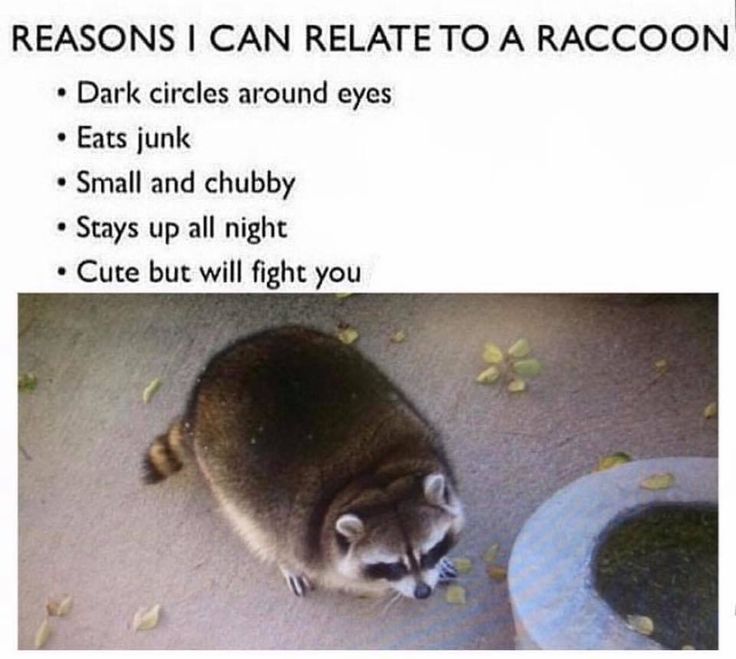
[top]
Housing juvenile raccoons
The type of outside enclosure you use for your raccoons will depend upon your rehabbing methods. Up to 4 raccoons can be placed in a cage measuring 24'X8'X8'. Cages measuring 6'X6'X12' long are also satisfactory. Wire should be 1"X2" welded wire. Fiberglass panels should be placed on the ends to protect them from the weather (Evans & Evans, 1985). Some rehabbers use a very large enclosure, complete with tree(s), child's wading pool, various climbing items and other toys, feeders, and wooden boxes for beds. They may have several litters together and the older ones help teach the younger ones numerous skills. Many raccoons will stay within this type of enclosure until their final release. They should be released in a area with feeders that are regularly restocked until you are sure they no longer need them. I use a smaller enclosure with just branches, toys, their food bowl, litter box and bed (animal carrier). All their other activity takes place in the woods themselves and I start taking them on daily excursions when they are about 10 weeks old.
[top]
Dealing with imprinting and other problems
While bottle feeding does make raccoons bond with you, when they are being rehabbed with littermates they do not imprint as heavily on their human surrogate mother as a single orphaned one would. As they grow, they will prefer the company of their littermates over you. If at all possible, try to never rehab a single raccoon. Contact another rehabber in your area and see if you can merge your rehabs once they have received clean bills of health for distemper and roundworm.
Physical affection should be lavished upon nursing raccoons. Once they are weaned, you need to start distancing yourself from them, to break the human bond. Also start limiting their human contact to just yourself.
As they get older they will get quite playful, which increases the chances of your being bit. Use precaution and heavy gloves and make it clear that they are not to rough house with you. Sharply say "NO" and growl or hiss at them. If they are by you at the time, gently shake the scuff of their neck while you do this. The scuff of the neck works well with raccoons - their moms carry them by it, shake them by it and will pin them down by it when they really tick mom off. You grab just skin and fur. They can't turn their head around enough to bite you and if you pick them up that way they usually just hang there quite docile (must be instinctive.) This should never be attempted with wild or adult raccoons but I find it quite effective while I am still their "mother".
If they are by you at the time, gently shake the scuff of their neck while you do this. The scuff of the neck works well with raccoons - their moms carry them by it, shake them by it and will pin them down by it when they really tick mom off. You grab just skin and fur. They can't turn their head around enough to bite you and if you pick them up that way they usually just hang there quite docile (must be instinctive.) This should never be attempted with wild or adult raccoons but I find it quite effective while I am still their "mother".
[top]
Preparing a raccoon for release
At about 10 weeks of age, I start taking the raccoons for daily excursions. At this age they will follow me like little ducklings but as they get older the bravest of any litter can easily lead the others quickly astray - so be prepared. A wheel barrel filled with water is not only great fun for them play in but, when stocked with minnows, teaches them how to fish. Rumaging around in the leaves on the ground can yield all sorts of things to eat.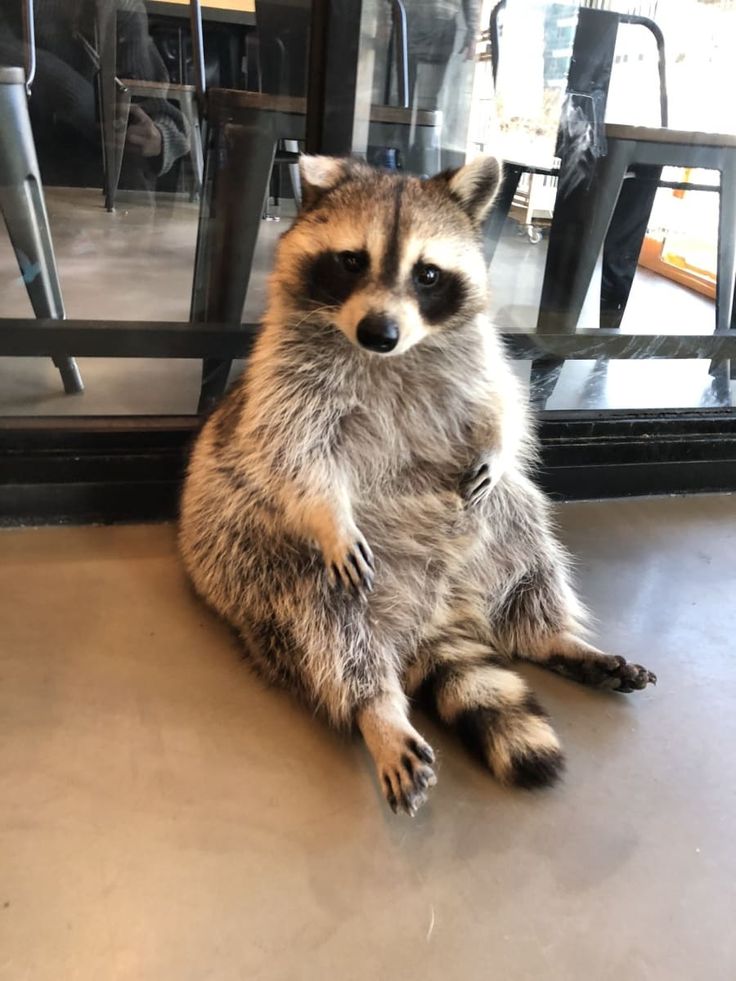
I lead them to smaller isolated trees where they can be more easily retrieved or coaxed down with a bribe. The first couple of times, they may be a little leery and you might have to help them up and down. After that, they discover all the good things about trees (food, shelter, fun) and you'll find them making a run for the trees.
Then I start to let them out by themselves, gradually building up from a few hours each day, to half a day, to overnight for a day or more at a time. Each time they visit their food bowl less and less, sustaining themselves on nature's offerings instead, and it becomes harder and harder to coax them to me. And sometimes they start to turn almost nocturnal. It is then that I make the final catch and release them into non-hunting areas in the areas where they were born. I do leave food and check back but it is more for me than for them - they do not need my help anymore, they have successfully returned to the wild.

[top]
Tips for becoming a rehabber, links and more info will be posted shortly. Check back.
Please see my other pages of raccoon facts & info and Rabies & other diseases.
Copyright 1997-2009 The Gable
All rights reserved.
See Copyright and Disclaimer notices.
How to feed a raccoon puppy | House of the Raccoon
Tiny
So, the long-awaited baby is home! What's next? How to feed a raccoon puppy ? What else is needed for him to survive and grow up healthy and cheerful? In short, the following is required: 1) Determine the approximate age of puppy and, more importantly, its development. 2) Feed correctly 3) Do massages 4) Provide a comfortable temperature and a safe place
Only puppies older than 2 weeks can be kept like this during feeding! NOTE!
Raccoon
All these moments are very important for the survival and rearing of the baby raccoon .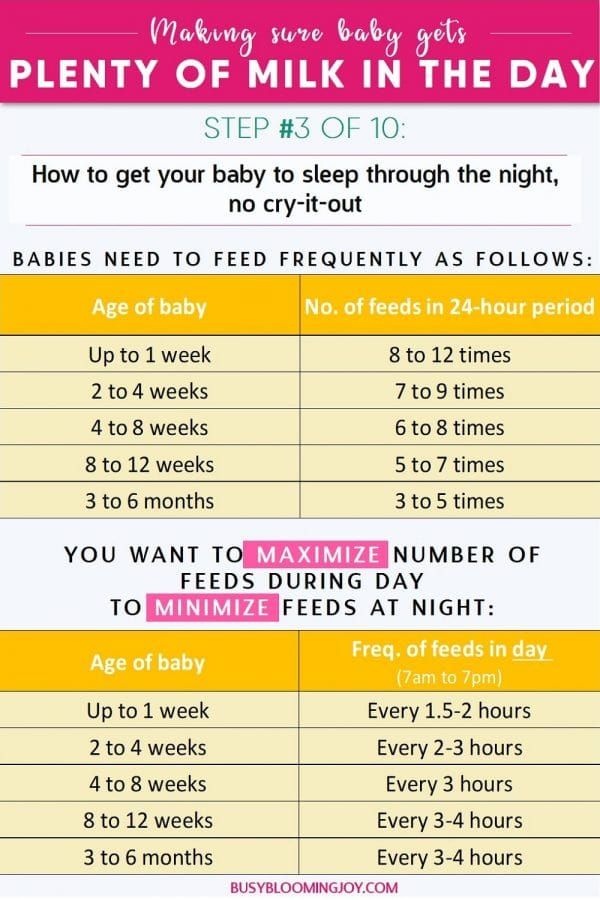 None of them can be passed over as less significant. Let's take a look at each of these points in order and in as much detail as possible. So definition of age and development. Everything else depends on this. The age of a raccoon and its development are two different factors. In dogs and cats, most often the specific age of the puppy implies a specific development. In raccoons the situation is much more complicated. For example: Last year, one owner had two females at about the same time brought raccoon puppies . The conditions of keeping, feeding and care for both female raccoons were the same. Only the age of females and males-fathers of raccoon puppies differed. At the age of 3 weeks, the puppies of both females were about the same size, weight and behavior. But by 5 weeks, weight and behavior began to differ significantly. The babies of the first female at 5 weeks old began to open their eyes and actively crawl around the den. The second mother's children began to open their eyes only at 8 weeks.
None of them can be passed over as less significant. Let's take a look at each of these points in order and in as much detail as possible. So definition of age and development. Everything else depends on this. The age of a raccoon and its development are two different factors. In dogs and cats, most often the specific age of the puppy implies a specific development. In raccoons the situation is much more complicated. For example: Last year, one owner had two females at about the same time brought raccoon puppies . The conditions of keeping, feeding and care for both female raccoons were the same. Only the age of females and males-fathers of raccoon puppies differed. At the age of 3 weeks, the puppies of both females were about the same size, weight and behavior. But by 5 weeks, weight and behavior began to differ significantly. The babies of the first female at 5 weeks old began to open their eyes and actively crawl around the den. The second mother's children began to open their eyes only at 8 weeks. And active crawling out of the lair began at 9weeks. The babies of the first female at that time already saw perfectly well, kept well on their paws and began to try food from their mother's bowl. They were painlessly transferred to soaked dry food for small puppies under the mother at 7 weeks. The babies of the second mother, up to 12 weeks, had to be bottle-fed with a milk-banana mixture, and only by 16 weeks they began to eat solid food and firmly stood on their paws. This is the difference I have in mind when I talk about development. So, we examine our baby: 1) how confidently does he hold on to his paws, does he completely raise the body above the ground or do the paws spread and only sometimes does the baby collect them under him? Until the baby fully confidently stands on its paws, it will have to be fed from a bottle with a banana-milk mixture. Not to be confused with braiding the paws while moving! For a long time, the baby will learn to control them, especially when cornering, but he must confidently keep his body on them.
And active crawling out of the lair began at 9weeks. The babies of the first female at that time already saw perfectly well, kept well on their paws and began to try food from their mother's bowl. They were painlessly transferred to soaked dry food for small puppies under the mother at 7 weeks. The babies of the second mother, up to 12 weeks, had to be bottle-fed with a milk-banana mixture, and only by 16 weeks they began to eat solid food and firmly stood on their paws. This is the difference I have in mind when I talk about development. So, we examine our baby: 1) how confidently does he hold on to his paws, does he completely raise the body above the ground or do the paws spread and only sometimes does the baby collect them under him? Until the baby fully confidently stands on its paws, it will have to be fed from a bottle with a banana-milk mixture. Not to be confused with braiding the paws while moving! For a long time, the baby will learn to control them, especially when cornering, but he must confidently keep his body on them. 2) Eyes. Only if the baby has clean, without blue lanyards, completely open, meaningfully looking eyes, can he be fed “in an adult way”. If there is an infantile languor (blueness) on the eyes, if the gaze is wandering and inattentive, your food is in the bottle. So, we have formed two types of baby's age: for a bottle and for soaked food. And you can’t confuse them, ruin the baby! While the baby is feeding from a bottle, your obligatory worries are added: 1) Sterilization of the bottle 2) Massage of the tummy and anus until the result. 3) Temperature control
2) Eyes. Only if the baby has clean, without blue lanyards, completely open, meaningfully looking eyes, can he be fed “in an adult way”. If there is an infantile languor (blueness) on the eyes, if the gaze is wandering and inattentive, your food is in the bottle. So, we have formed two types of baby's age: for a bottle and for soaked food. And you can’t confuse them, ruin the baby! While the baby is feeding from a bottle, your obligatory worries are added: 1) Sterilization of the bottle 2) Massage of the tummy and anus until the result. 3) Temperature control
where to buy a raccoon
DO NOT hold the baby during feeding!!!!
4) Sucking reflex compensation (finger). At this age, babies are not yet able to regulate their body temperature. Easy to catch cold and overheat. This issue is best solved by placing the raccoon in a rather large cardboard box with high walls. We cover the box with terry towels. In one of the corners we put plastic one and a half liter bottles with warm water. When the baby is cold, he will climb into this corner. Bottles can be replaced with heating pads. But do not forget, firstly, to change the water more often as it cools down, and secondly, make sure that the baby has somewhere to crawl if it gets hot. These recommendations do not apply to babies who do not actively crawl themselves. How to deal with them, I will tell separately. Feeding babies : So, very young babies, before opening their eyes, you can try to feed them with cat's milk replacer. NEVER FEED MILK!! This applies to all types of milk: cow's, goat's, lactose-free... There were cases of successful nursing in Russia, but there were also sad stories. Therefore, I decided to clarify this issue with foreign colleagues from the Forest Infant Rehabilitation Center in Canada. Their advice can be read here. Not every mixture is suitable - a milk replacer. In Russia, it is desirable to find one. If there are discrepancies in the articles, please clarify in the comments: now we are closely studying this issue.
When the baby is cold, he will climb into this corner. Bottles can be replaced with heating pads. But do not forget, firstly, to change the water more often as it cools down, and secondly, make sure that the baby has somewhere to crawl if it gets hot. These recommendations do not apply to babies who do not actively crawl themselves. How to deal with them, I will tell separately. Feeding babies : So, very young babies, before opening their eyes, you can try to feed them with cat's milk replacer. NEVER FEED MILK!! This applies to all types of milk: cow's, goat's, lactose-free... There were cases of successful nursing in Russia, but there were also sad stories. Therefore, I decided to clarify this issue with foreign colleagues from the Forest Infant Rehabilitation Center in Canada. Their advice can be read here. Not every mixture is suitable - a milk replacer. In Russia, it is desirable to find one. If there are discrepancies in the articles, please clarify in the comments: now we are closely studying this issue.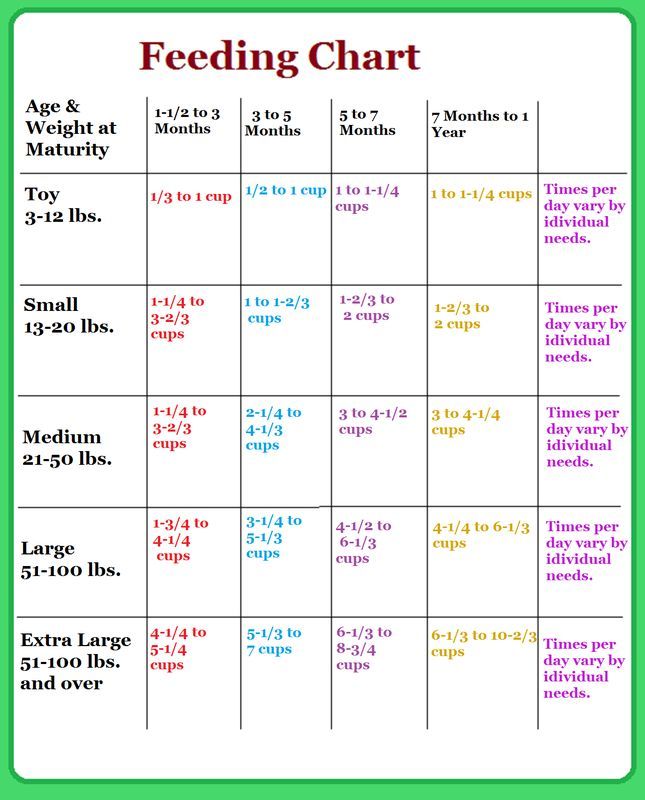
Here it is important not to overfeed the baby, but also not to starve. After feeding, the raccoon puppy should calmly sleep sweetly for 3-4 hours. If he wakes up earlier, you are underfeeding; if he sleeps further, you are overfeeding. Daily weighing is not unimportant! Weight must always increase! Let just a little, but grow. Therefore, you will definitely need electronic scales. Also during this period, massage of the tummy and perineum is especially important. Enetenok himself can neither write nor poop. Massage of the tummy is performed immediately after feeding and in the interval between feedings. The massage is performed as follows: with soft circular movements clockwise we stroke the tummy, slightly pressing. After two or three minutes of massage, lift the ponytail almost perpendicular to the back and slap the anus with gentle movements, lifting the ass with an upward movement. In case of constipation, first lubricate the ass with plenty of Vaseline. Next, we put the raccoon on the palm, so that the index finger is on the raccoon's pussy, and pat it until urination. Ideally, the chair should be after each feeding. And if this does not happen, we repeat the massage every 40-50 minutes until the result. The main thing is that the tummy is soft and painless. In case something worries you, read "first aid for a baby: tummy hurts." If the baby drinks 40 ml of milk, eagerly, without releasing the bottle, but sleeps for only an hour and wakes up again, there is a reason to increase the nutritional value of milk. In each feeding, we begin to add a slice of banana to milk, we start with a piece of banana 1 cm thick. The next feeding is already 3 cm and if diarrhea does not appear, in the next feeding we already make a mixture of half a banana and 100 ml of milk. If the baby is weakened, leave the banana share small and add 1 tablespoon of rice water. Banana + milk - the main mixture for feeding a baby raccoon of the first period of development. When loose stools appear, a spoonful of rice broth or a spoonful of oak bark decoction is added to the mixture. If mucus appears in the stool, an admixture of blood, or it has acquired a green color or a fetid odor, these are good reasons to see a doctor.
Ideally, the chair should be after each feeding. And if this does not happen, we repeat the massage every 40-50 minutes until the result. The main thing is that the tummy is soft and painless. In case something worries you, read "first aid for a baby: tummy hurts." If the baby drinks 40 ml of milk, eagerly, without releasing the bottle, but sleeps for only an hour and wakes up again, there is a reason to increase the nutritional value of milk. In each feeding, we begin to add a slice of banana to milk, we start with a piece of banana 1 cm thick. The next feeding is already 3 cm and if diarrhea does not appear, in the next feeding we already make a mixture of half a banana and 100 ml of milk. If the baby is weakened, leave the banana share small and add 1 tablespoon of rice water. Banana + milk - the main mixture for feeding a baby raccoon of the first period of development. When loose stools appear, a spoonful of rice broth or a spoonful of oak bark decoction is added to the mixture. If mucus appears in the stool, an admixture of blood, or it has acquired a green color or a fetid odor, these are good reasons to see a doctor. The ways of feeding the baby of the first period of development are varied and are selected from the preferences of the baby. Someone successfully learns to suck a nipple on a bottle, someone can be fed only from a syringe without a needle and kutya, someone begins to lap from a saucer, getting into it with all four paws. In Canada, feeding through a wheat straw or a cocktail tube directly from the owner's mouth is popular. Raccoons are stubborn and stubborn. And that's how they are born. And no hunger will make a youngster suck a pacifier if he doesn't like it. The first attempts in any case will take place with a fight and squeals. But if you are attentive and patient, you will quickly feel for yourself exactly how, in what way your baby agrees to eat. I wish you success.
The ways of feeding the baby of the first period of development are varied and are selected from the preferences of the baby. Someone successfully learns to suck a nipple on a bottle, someone can be fed only from a syringe without a needle and kutya, someone begins to lap from a saucer, getting into it with all four paws. In Canada, feeding through a wheat straw or a cocktail tube directly from the owner's mouth is popular. Raccoons are stubborn and stubborn. And that's how they are born. And no hunger will make a youngster suck a pacifier if he doesn't like it. The first attempts in any case will take place with a fight and squeals. But if you are attentive and patient, you will quickly feel for yourself exactly how, in what way your baby agrees to eat. I wish you success.
feeding raccoon puppies
| Age (weeks) | Feeding formula | Important | Special care |
| Birth to 1 week 60-140 grams Eyes and ears closed muzzle mask and tail rings barely visible scanty fluff of fur on the back and sides, no fur on the belly
| Serving 3 - 7 ml. nutrition (this is approximately 5% of body weight) 7-8 times a day every 2.5 - 3 hours, including night feedings. An example of a feeding schedule for 8 times a day: 7:00,9:30, at 12 :00, 14:30, 17:00, 19:30, 22:00, plus once during the night. nutrition (this is approximately 5% of body weight) 7-8 times a day every 2.5 - 3 hours, including night feedings. An example of a feeding schedule for 8 times a day: 7:00,9:30, at 12 :00, 14:30, 17:00, 19:30, 22:00, plus once during the night. Example of a feeding schedule for 7 times a day: 7:00, 10:00, 13:00, 16:00, 19:00, 22:00, plus one during the night. Feeding formula should be warmer than body temperature as it cools quickly as it passes through the nipple or feeding syringe, so keep the feeding bottle in a larger cup of warm water while feeding. | Keep baby warm in a pet carrier or small closed box with breathing holes. Protect them from drafts, and create a cozy nest with several layers of soft fabric. Change bedding twice a day, and wash them without using rinse aid because the smell is bad for babies' respiratory system. Provide outside warmth by putting a heating pad or a bottle of warm water wrapped in a soft cloth. Make sure it doesn't leak and isn't too hot for the baby to cuddle up with.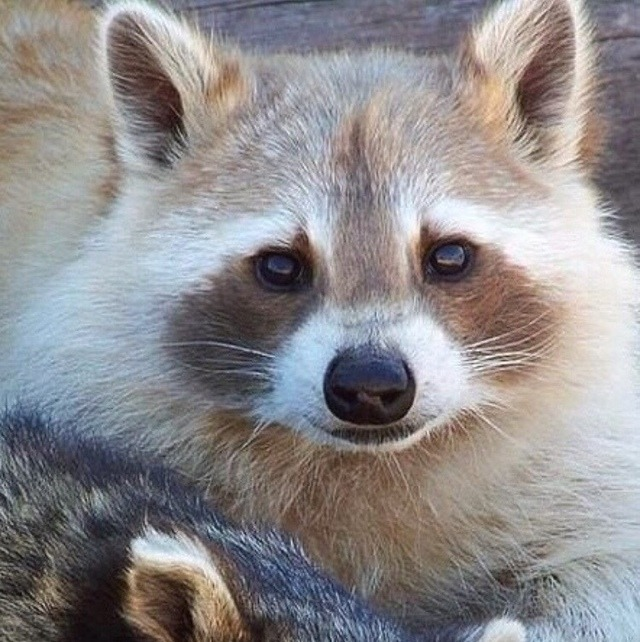 Change before next feeding or when cool. Change before next feeding or when cool. | Keep baby warm at all feeding times by wrapping in a warm cloth, cage or box at all times with a heating pad or hot water bottle. Feed him in a quiet, warm environment with no distractions. Try to provide extra sucking time by wearing latex gloves over light cotton gloves and letting them suck your fingers for 10 or 15 minutes after each feed. Stimulate him at every feed by gently stroking the genital area with a wet finger or Q-tip or soft damp cloth until he has finished urinating and/or defecation. Thoroughly wash face, neck and chin after each feeding. After the baby has digested the food, the stool should be formed and golden brown. Maintain proper hygiene, as raccoon feces can contain parasites. |
| 2 weeks190-225 grams slightly pubescent no belly fur Eyes and ears closed | Serving 9.5 - 11.3 ml nutrition (that's about 5% of body weight) 6 times a day every 3 hours Example of a feeding schedule for 6 times a day: 7:00, 10:00, 13:00, 16:00, 19:00, 22:0 |
Same as |
Same as |
3 weeks 320-400 gr.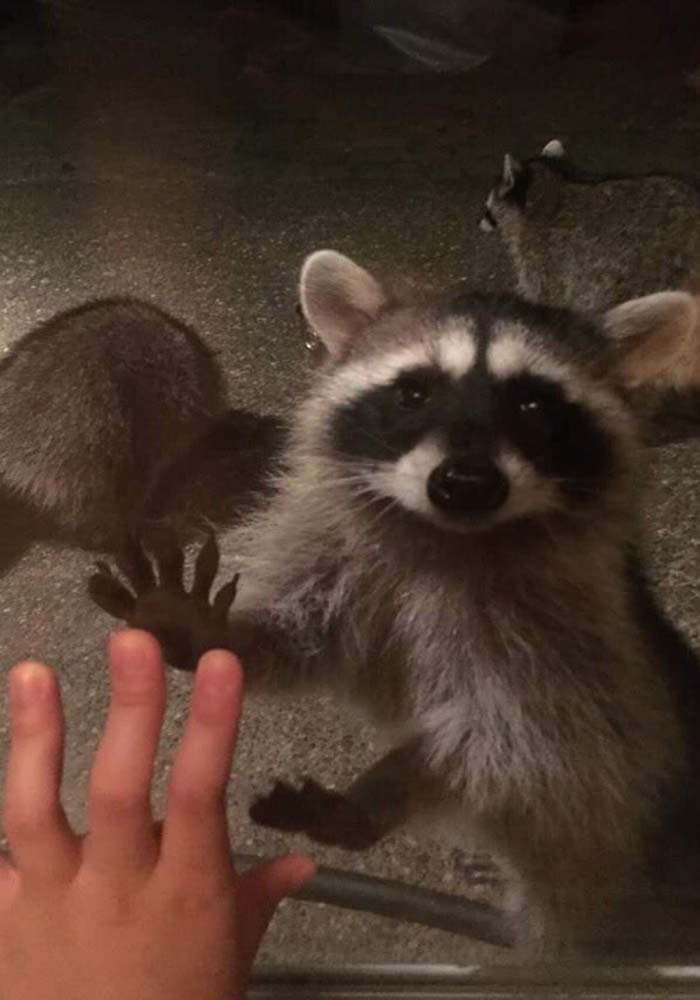 full fur Eyes open at about 3 weeks (18 to 24 days of age)
| Serving 16 - 20 ml nutrition (that's about 5% of body weight) 6 times a day every 3 hours | Same as | The same Since babies become more inquisitive after opening their eyes, it is important to continue feeding them in a quiet room without any distractions. Babies can already suck from a bottle on their own. If you have several babies, you can secure several bottles on a wooden base with rubber rings. |
| 4 weeks450-550 grams
| Serving 22.5 - 27.5 ml nutrition (5% of body weight) or Serving 31.5 - 38.5 ml (7% of body weight) 5 times a day every 3.5 hours Example of a feeding schedule for 5 times a day: 7:00, 10:30, 14:00, 17:30, 21:00 | Same as | Same as |
| 5 weeks600-700 grams | Serving 30-35 ml nutrition (5% of body weight) OR Serving 42 - 49 ml (7% of body weight) 4 times a day every 4 hours Example of a feeding schedule for 4 times a day: 7:00, 11:00, 15:00, 19:00 | Same as | After a week or two of babies have opened their eyes, they can urinate on their own, you can start to teach them to go to the toilet on paper towels.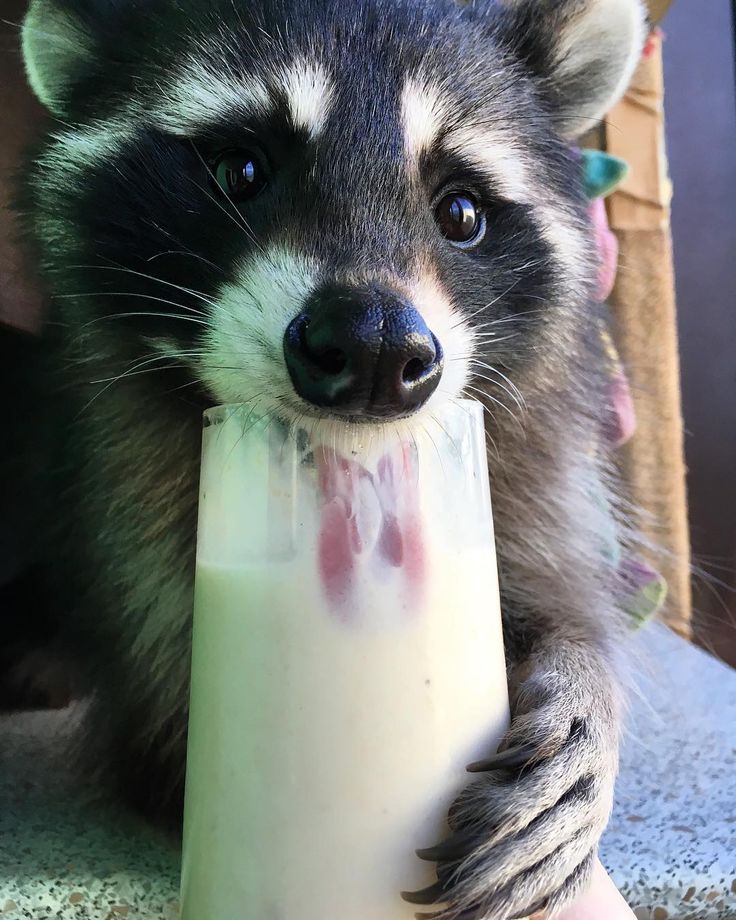 You can encourage them to urinate so they know where to go. Constantly monitor the cleanliness in the cage, change paper towels in a timely manner. You can encourage them to urinate so they know where to go. Constantly monitor the cleanliness in the cage, change paper towels in a timely manner. |
| 6 weeks750-820 grams | Serving 37.5 - 41ml nutrition (5% of body weight) OR Serving 52.3 - 55.4 ml (7% of body weight) 4 times a day every 4 hours Example of a feeding schedule for 4 times a day: 7:00, 11:00, 15:00, 19:00 Solid foods, good quality puppy food and cut fruit (grapes and bananas are preferred) may be introduced. Soak puppy food with nutrition first or mix banana puree with nutrition. Heat in the microwave until the granules are completely dissolved.
| Provide a source of clean drinking water, wash a cup of water several times a day and change the water. | You can use sand or kitten litter for potty training. The cage and tray should be cleaned and washed frequently, and the bedding should be changed daily. |
| 7 weeks900-1000 grams | Serving 45 - 5 0ml nutrition (5% of body weight) OR Portion 63 - 70 ml (7% of body weight) 4 times a day every 4 hours Example of a feeding schedule for 4 times a day: 7:00, 11:00, 15:00, 19:00 After they eat puppy food, stop soaking it and increase the amount of solid food. | Same as | Same as |
| 8 - 10 weeks 1000-1450 g | Serving 50 - 72.5ml nutrition (5% of body weight) OR Serving up to 80 ml per feeding 3 times a day every 5 hours Example of a feeding schedule for 3 times a day: 8:00, 13:00, 18:00 | Same as | Weaning Note: Do not increase feed volume above 80 ml, feed more solid food, and if the raccoons are not fed, they will be forced to eat solid food. |
| 10 - 16 weeks Raccoons born in the spring (March - May) should weigh about 6-7 kg by August-September at 16-18 weeks. | Feeding puppy food (about 2/3 of the diet) and fresh fruits and vegetables (about 1/3 of the diet). Adult dog food does not meet all the needs of a growing animal. | In the cage, make hammocks from hard fabric and ropes, various climbing frames, hang swings from tires. |
You can read more about keeping raccoons at home in the book "Poloskun Raccoon" https://ridero.ru/books/enot-poloskun/
Breeding of raccoons and raccoon dogs, features of care, feeding, breeding, diet
04.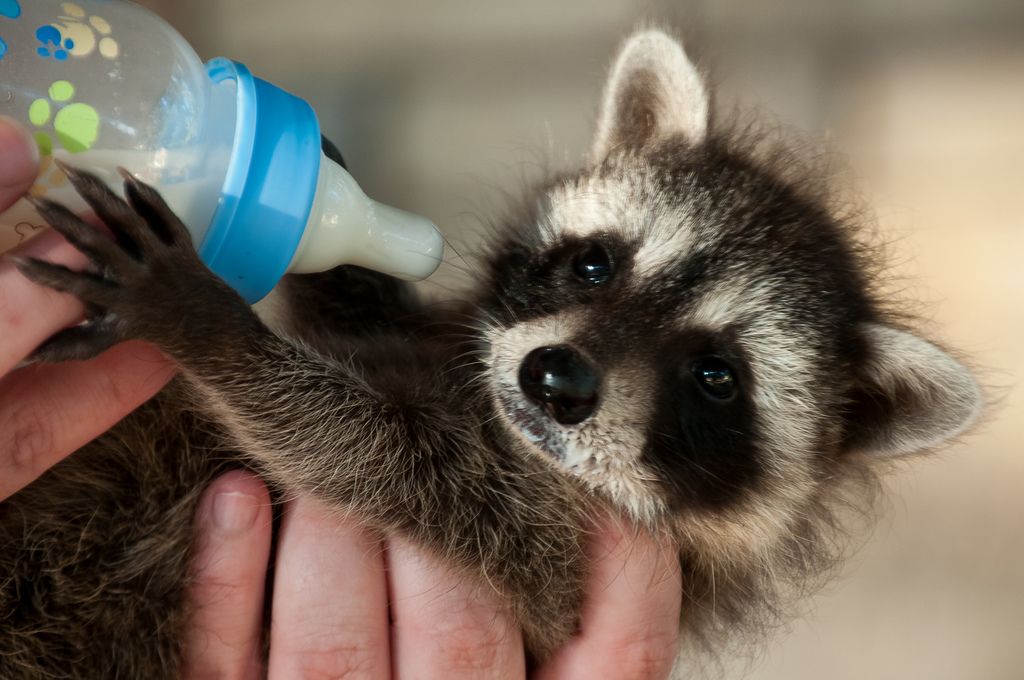 11.2019
11.2019
Continuing the topic of fur farming, today I want to dwell in detail on the features of keeping and breeding raccoons. Raccoon fur has three complementary tones at the same time: black, red and brown. This combination creates a play of color when viewed from different angles, depending on the intensity of lighting, it changes shade and looks very beautiful in various products. Hats, fur coats, collars from it look very voluminous, fluffy, warm and solid.
Raccoon fur is really very warm and light. The ability to keep warm and accentuated volume is due to the fact that the awn of raccoon fur is long, shiny and hard, and the undercoat is soft and very thick. In addition to its visual appeal, this fur has several very advantageous practical features. Products from it are much more durable than, for example, from fox fur. You can wear it for many seasons (10 - 15), and with proper care, the clothes will retain their elegant appearance, the wool does not fall out, does not fall off, does not break. Even raccoon fur is not afraid of getting wet, like rabbit or ferret fur. In case of precipitation, it is enough just to shake it.
Even raccoon fur is not afraid of getting wet, like rabbit or ferret fur. In case of precipitation, it is enough just to shake it.
There are two "suppliers" of raccoon fur. This is himself raccoon and raccoon dog . Outwardly, they are similar, and their fur is also similar, but the similarity is only external. The raccoon and the raccoon dog are not related, they belong to different species and different families. The raccoon belongs to the raccoon family, and the raccoon dog belongs to the canine family. There are big differences in their body structure, behavior and physiology. The homeland of raccoons is North America, and raccoon dogs are the Far East, Japan, Mongolia, Korea, China, Indochina.
Both species were brought to the territory of Eurasia by humans quite a long time ago and acclimatized well here. In some countries of Western Europe, animals have spread so actively that they began to crowd out the local fauna and created an environmental problem. At present, their populations have reached such numbers that they allow hunters to carry out commercial production of wild animals for their fur.
At present, their populations have reached such numbers that they allow hunters to carry out commercial production of wild animals for their fur.
In our country, in order to obtain valuable fur, animals are bred in specially created conditions on a few fur farms. The fur of such animals is much better than that obtained as a result of commercial hunting. This is explained by the fact that on the farm, animals receive a properly balanced and plentiful diet. In addition, constant targeted breeding work is carried out to improve the fur qualities and increase the size of raccoons (raccoon dogs): successful combinations are selected when forming parental pairs; animals with low quality fur are culled.
Fur farms contain mainly raccoon dogs. In comparison with raccoons, these animals are more practical in terms of economic qualities. A raccoon dog at the withers reaches 40 cm, has a very lush coat up to 12 cm long. The fur of these animals is especially beautiful in the autumn-winter period. The tail of the animal is lowered down, of medium length - from 15 to 26 cm, fluffy. The head is small, the ears are small, erect. The eyes are almond-shaped, small. The muzzle is short, pointed.
The tail of the animal is lowered down, of medium length - from 15 to 26 cm, fluffy. The head is small, the ears are small, erect. The eyes are almond-shaped, small. The muzzle is short, pointed.
There are two varieties of the color of the raccoon dog: silver and silver-orange , but occasionally white is also found. The coloring of different parts of the body coincides with the color of the coat of the striped raccoon: a mask on the muzzle, light sideburns, black edging of the ears, for which this animal got its name.
The live weight of an adult male is about 9.5 kg, but some individuals grow up to 10 - 11 kg. Females are slightly smaller, their weight ranges from 7.5 kg to 8 kg. The body length of animals usually reaches 64 - 67 cm, but some males grow up to 70 - 75 cm. Such animals are of particular interest in the breeding sense, and they are often selected for further breeding.
The life expectancy of a raccoon dog is on average about 14 to 16 years, but it is advisable to use them on a farm for up to five to six years.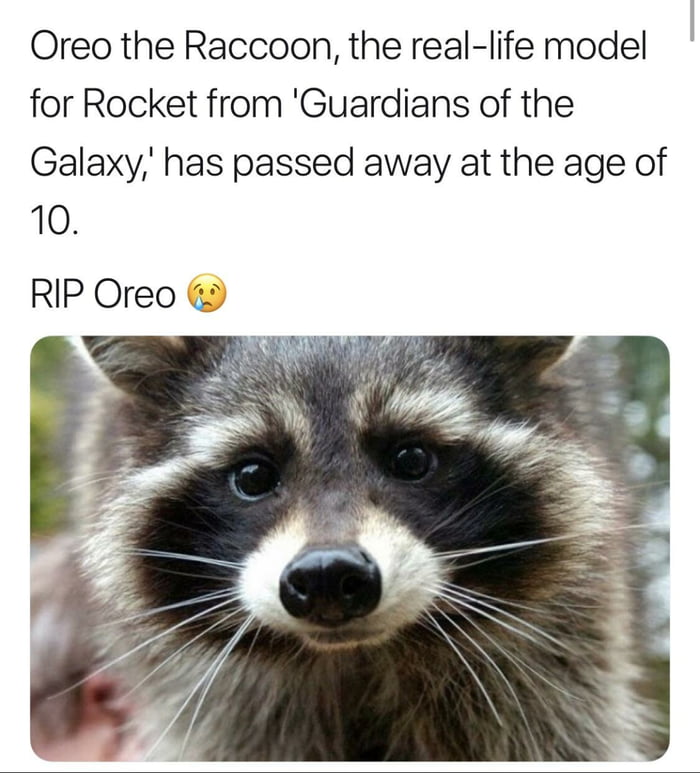 In older animals, a decrease in reproductive qualities is often observed: females are fertilized worse, and males older than four years old become inactive.
In older animals, a decrease in reproductive qualities is often observed: females are fertilized worse, and males older than four years old become inactive.
Raccoon dogs are less clean than raccoons and have a specific smell. They swim well. If the need arises, wild animals can swim across fairly large water barriers. They are dexterous and very strong, but peaceful animals, they do not start conflicts with representatives of other species. Males can become aggressive during the rut, as well as parents during the rearing of offspring. They are wary of strangers on the farm, they may try to defend their territory. They feel better in cool weather, raccoon dogs tolerate heat worse. This feature should be taken into account when placing sheds and provide for their natural shading.
It is most convenient to keep raccoon dogs in cages placed in sheds for shading and protection from wind and precipitation. The size of an individual cage can be as follows: length - 2 m, width - 1.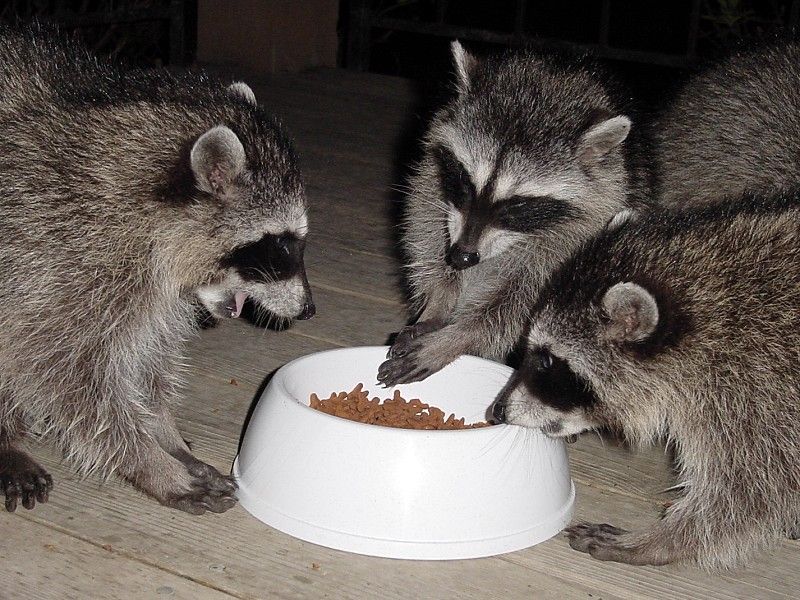 2 m, height - 0.8 m. The floor of the cage in winter must be covered with a wooden shield, otherwise animals freeze their paw pads in severe cold. Another prerequisite is the constant presence of a nesting house for both females and males throughout the year. In nature, raccoon dogs live in burrows, so keeping animals in a cage with a house is more natural, corresponding to their physiology.
2 m, height - 0.8 m. The floor of the cage in winter must be covered with a wooden shield, otherwise animals freeze their paw pads in severe cold. Another prerequisite is the constant presence of a nesting house for both females and males throughout the year. In nature, raccoon dogs live in burrows, so keeping animals in a cage with a house is more natural, corresponding to their physiology.
Raccoon dogs have an interesting physiological feature: they hibernate in winter, just as it happens in bears and some other animals. Raccoon dogs living in the wild from November to January reduce their activity and metabolic rate, sleep a lot, do not leave their holes, do without food and water.
In a farm, hibernation of raccoon dogs depends on the conditions of their maintenance and the technology chosen by the farm. Usually it is not as pronounced as in nature, but it can also be traced. During this period, animals should not be disturbed by feeding or various veterinary procedures. On the farm at this time, bright lighting and loud sounds should be excluded, strangers and stray animals should not be allowed.
On the farm at this time, bright lighting and loud sounds should be excluded, strangers and stray animals should not be allowed.
Feeding adult raccoon dogs during the active period of their life is carried out twice a day in equal portions. Young animals and females with cubs are recommended to be fed three times a day ad libitum. A raccoon dog in natural conditions feeds on small rodents, fish, frogs, lizards, insects, bird eggs, birds themselves, carrion, succulent fruits of plants, and sometimes seeds. In artificial conditions, it is also very unpretentious in feed, but do not forget that this is a predator, so feed of animal origin should prevail in their daily diet.
The daily diet for an adult animal may look like this: meat and offal - 300 g, fish - 50 g, incubator waste or 2 - 3 eggs, cereal porridge in meat broth - 350 g, vegetables - 200 g, animal fats - 20 g , salt - 10 g, fish meal - 5 g, meat and bone meal - 5 g.
Feed can be given in the form of a homogeneous mass or separately for each type.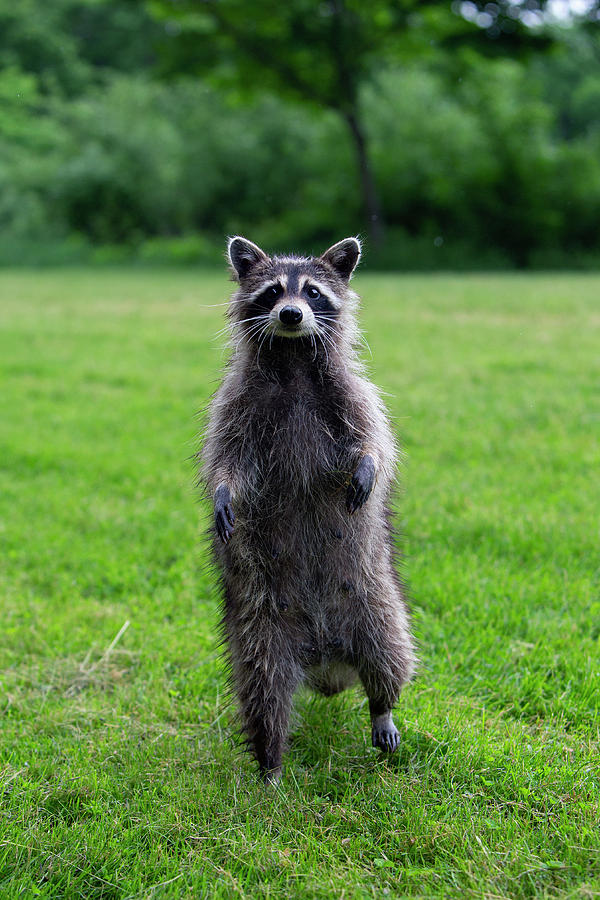 Meat and bone, fish meal, fats and salt are best mixed with ready-made porridge. Separately, you can give a small amount of sweet fruits: pears, plums, grapes, cherries. The diet, of course, varies depending on the time of year and the availability of seasonal feed.
Meat and bone, fish meal, fats and salt are best mixed with ready-made porridge. Separately, you can give a small amount of sweet fruits: pears, plums, grapes, cherries. The diet, of course, varies depending on the time of year and the availability of seasonal feed.
Drinking water for a raccoon dog must be available at all times. According to their physiology, animals should gain weight over the summer, so do not worry if you notice that your animals get a little fat during the summer-autumn period. During the winter decrease in activity and hibernation, raccoon dogs are not fed at all. The duration of hibernation on fur farms depends on many conditions and varies from several days to one and a half months.
Reproduction in raccoon dogs is seasonal. The rut (mating season) occurs once a year, at the end of winter. Usually this is the period from the end of January to the end of March. Puberty in animals occurs from 10 to 11 months. You can mate them on the very first hunt, by which time they are already sufficiently developed to bear offspring.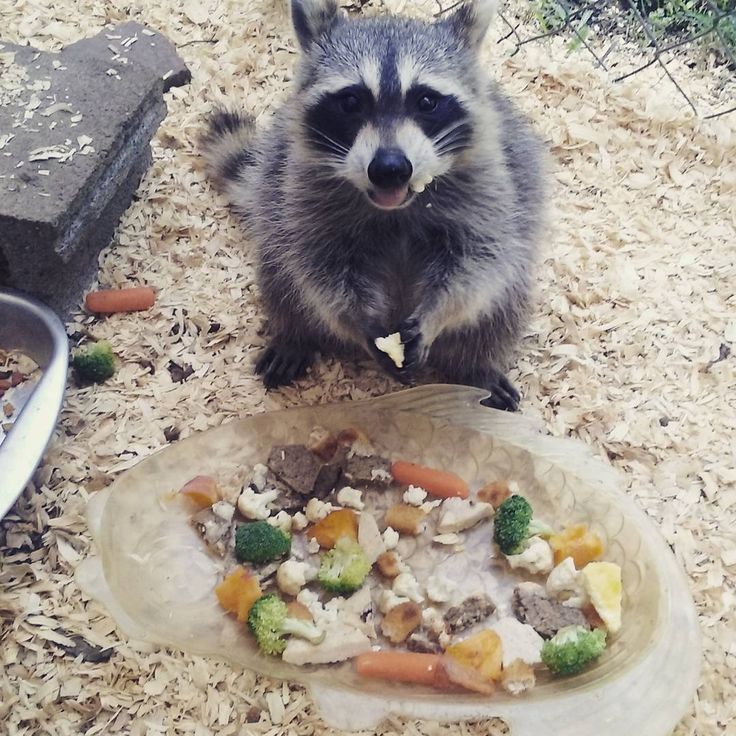 For breeding, you can keep one male for several females or keep the parent stock of females and males in pairs.
For breeding, you can keep one male for several females or keep the parent stock of females and males in pairs.
With pair keeping, the cost of feeding and the need for space for the parent stock are much higher than in the first option, but the fertility and fertility of females are also much higher. In addition, no participation is required from a person in conducting a breeding campaign at a fur farm. If one male is used to cover several females, then the female in the hunt is detected by a person with the help of observation and trial seating of females to the male. The estrus lasts about two weeks, but the time favorable for fertilization is only 3-5 days. On these days, the female must be covered several times (to fertilize the maximum possible number of eggs), which is quite laborious if there are many animals. Favorable time for mating is also difficult to determine. A male can cover two females per day.
A pair of raccoons constantly living together mates itself at the optimal time and the optimal number of times. The fertility of females living in pairs is 7 - 9 puppies. Those who live separately - no more than 5, 6 puppies. Pregnancy lasts from 58 days to 63, in most it lasts 61 days. After the onset of pregnancy, it is better to remove the male from the female in an adjacent cage, but in such a way that they remain nearby and see each other.
The fertility of females living in pairs is 7 - 9 puppies. Those who live separately - no more than 5, 6 puppies. Pregnancy lasts from 58 days to 63, in most it lasts 61 days. After the onset of pregnancy, it is better to remove the male from the female in an adjacent cage, but in such a way that they remain nearby and see each other.
The behavior of a pregnant female from the third week of pregnancy (the so-called pregnancy in canines) changes. She becomes less mobile, sleeps more in the nesting house, moves carefully, her appetite increases. A few days before whelping (the birth of cubs), the female builds a nest in the house. At this time, she needs to be provided with straw, which she herself will drag into the house. A day before the appearance of offspring, the female stops eating, plucks the fluff on her stomach, and worries.
Childbirth, as a rule, takes place before dawn, without complications, and does not require any participation from the person. Weight of puppies at birth: from 80 g to 120 g. It depends on the size of the female, her age and the number of puppies in the offspring. In young females, puppies are usually smaller. The larger the puppy at birth, the stronger, more active, it grows better, and a more valuable animal grows out of it. Males are often born larger than females. All puppies are born without teeth, blind and with closed ear canals. The coat on them is short, even, black.
Weight of puppies at birth: from 80 g to 120 g. It depends on the size of the female, her age and the number of puppies in the offspring. In young females, puppies are usually smaller. The larger the puppy at birth, the stronger, more active, it grows better, and a more valuable animal grows out of it. Males are often born larger than females. All puppies are born without teeth, blind and with closed ear canals. The coat on them is short, even, black.
Raccoon dogs are generally good parents. Mothers have a high milk yield, which allows you to feed up to 10 puppies. But if, after giving birth, an incessant restless squeak is heard from the nesting house, then the house must be opened and the offspring examined. This should be done carefully, because after giving birth, females are often aggressive and can bite noticeably. Normally, the cubs should lie in a tight pile and sleep.
If the puppies crawl around the house, squeak, cool, then most likely the female does not have milk or she does not feed her cubs. In this case, they need to be collected, warmed, and the female is injected subcutaneously with the drug "Oxytocin" at a dose of 5 units, after which, after 10-15 minutes, apply the puppies to her nipples. The drug "Oxytocin" is a hormonal agent. In this case, it will have an effect in two directions: firstly, it will increase milk flow, and the puppies will receive colostrum, without which they most likely cannot survive; secondly, it increases the mother's desire to take care of her offspring, makes the female more loyal to her cubs, and reduces aggression.
In this case, they need to be collected, warmed, and the female is injected subcutaneously with the drug "Oxytocin" at a dose of 5 units, after which, after 10-15 minutes, apply the puppies to her nipples. The drug "Oxytocin" is a hormonal agent. In this case, it will have an effect in two directions: firstly, it will increase milk flow, and the puppies will receive colostrum, without which they most likely cannot survive; secondly, it increases the mother's desire to take care of her offspring, makes the female more loyal to her cubs, and reduces aggression.
In most cases, such human intervention has a positive result. Weak and small puppies need to be fed for several days with a 10% glucose solution with ascorbic acid. If the offspring is very large (12 - 19 puppies), then they will simply not have enough nipples. Such an offspring must either be manually fed from the nipple, or divided among several other females that have calved during this period. This is done in the same way as in the previously described case with foxes.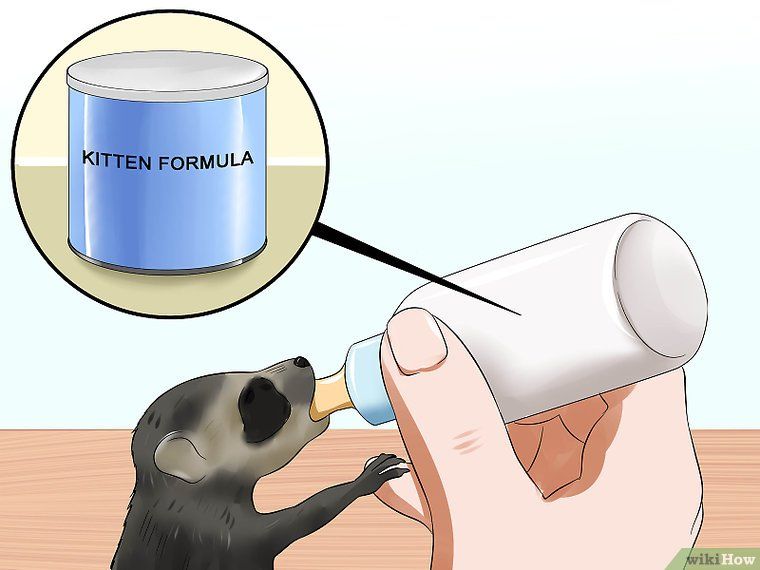
The eyes of puppies of raccoon dogs begin to open at the end of the first week of life, teeth appear at the end of the second week. From the end of the third week, puppies, if necessary, can be fed with minced meat. With normal milk production of the female, each puppy weighs about 850 - 900 g at the age of one month.
At 45 days of age, puppies can already be weaned from their mother. It is better not to transplant the grown young at once, but leaving a few pieces under the mother for a few more days. But, if the cage area allows, and the female is not very exhausted, then this should not be rushed. At the same time, it should be remembered that too late weaning of young animals can adversely affect the fatness of the mother and lead to the associated violation of her physiological annual cycle. Exhausted females do not hibernate, later they come to the next hunt, and their fertility in the next season is significantly reduced.
With abundant feeding (plenty), the young animals that are separated grow very quickly: at two months the puppies weigh 2. 5 kg each, at three months they grow to 4.5 - 5 kg, at four months they gain weight of 6.5 - 7 kg, and at five months they already reach the size and weight of adults. Puppies from early offspring grow and develop better than those that were born later. The difference in weight between such animals, all other things being equal, is up to 20%.
5 kg each, at three months they grow to 4.5 - 5 kg, at four months they gain weight of 6.5 - 7 kg, and at five months they already reach the size and weight of adults. Puppies from early offspring grow and develop better than those that were born later. The difference in weight between such animals, all other things being equal, is up to 20%.
Regardless of age, the seasonal molt in all healthy raccoon dogs begins in September and continues until the end of October. The back and rump are the last to shed, so it is by the state of this zone that its completion is determined. In November, selection of breeding young is usually carried out, and fur young are slaughtered.
Raccoon dogs have good health, and with strict observance of the simplest norms of animal hygiene on the farm, they do not get sick with anything. But preventive vaccinations should not be ignored. This will save you from unnecessary problems and significant losses. Mandatory vaccination of animals against canine distemper, leptospirosis and parvovirus enteritis, as well as against dermatomycosis. We must not forget that raccoons and raccoon dogs are more likely than all other animals to suffer from rabies. For preventive treatments against these diseases, conventional vaccines intended for vaccinating dogs (Vakderm, Multikan, Antirabic Vaccine, Nobivak, etc.) are suitable.
We must not forget that raccoons and raccoon dogs are more likely than all other animals to suffer from rabies. For preventive treatments against these diseases, conventional vaccines intended for vaccinating dogs (Vakderm, Multikan, Antirabic Vaccine, Nobivak, etc.) are suitable.
Of the three species of raccoons that exist in nature (raccoon, cozumel, crawfish), the most common is the raccoon, which includes 22 different subspecies (Barbados, Bahamian, Tresmarias and others). The raccoon is a nocturnal animal with a stocky build and medium size. Its weight can be from 5 to 10 kg, females are much smaller than males. The height of the animal at the withers is up to 35 cm, the length of the body, excluding the tail, is approximately 45–60 cm, the length of the tail is up to 25 cm. The tail is fluffy, has several well-defined transverse stripes. The head is small, but wide, the muzzle is pointed, of medium length.
On the muzzle of the raccoon there is always a characteristic dark "mask" and sideburns, a dark strip stretches from the nose to the forehead.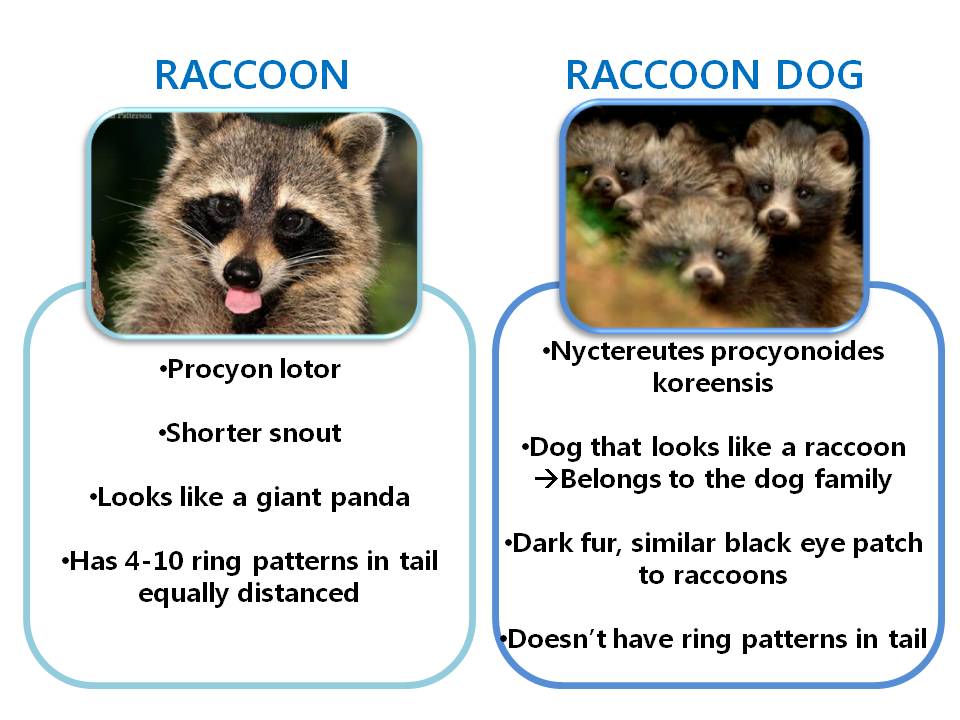 The paws of the striped raccoon (both hind and front) are similar to a human or monkey hand. The fingers are long and very mobile, with sharp claws, which allows animals to easily move through trees, cling to branches and perform various small actions when looking for food. Raccoons are very clean, they spend a lot of time cleaning and combing their luxurious fur, and before eating the food they find, they tend to rinse in the water of a pond or river, near which they like to settle.
The paws of the striped raccoon (both hind and front) are similar to a human or monkey hand. The fingers are long and very mobile, with sharp claws, which allows animals to easily move through trees, cling to branches and perform various small actions when looking for food. Raccoons are very clean, they spend a lot of time cleaning and combing their luxurious fur, and before eating the food they find, they tend to rinse in the water of a pond or river, near which they like to settle.
In nature, raccoons inhabit forest areas adjacent to water bodies, where they feed, without leaving their homes further than 1 - 1.5 km. Raccoons can swim well, but avoid deep water. The raccoon is very curious and bold, it easily adapts to any living conditions. Animals that have settled near people's homes can cause some inconvenience and sometimes even cause great harm, hosting gardens, kitchen gardens, chicken coops, scattering the contents of garbage cans.
In their natural habitat, raccoons live in large tree cavities, sometimes in rock crevices, or in burrows dug by other animals (they do not burrow themselves). They eat both plant and animal food. The diet of a wild raccoon includes bird eggs, chicks, insects, frogs, fish, crustaceans, larvae, lizards, mice, nuts, plant seeds, acorns, succulent fruits, succulent young shoots and plant roots. In winter, animals gather in hollows of several individuals and hibernate for several months. Raccoons living in warm climates with mild winters do not hibernate.
They eat both plant and animal food. The diet of a wild raccoon includes bird eggs, chicks, insects, frogs, fish, crustaceans, larvae, lizards, mice, nuts, plant seeds, acorns, succulent fruits, succulent young shoots and plant roots. In winter, animals gather in hollows of several individuals and hibernate for several months. Raccoons living in warm climates with mild winters do not hibernate.
Feeding raccoons has no clear norms. As food for them on the farm, you can use seasonal fruits, vegetables, small fish, silkworm pupae (silk spinning waste, which is abundant where this industry is developed), cereals from various cereals, bread, meat, offal. Most often, the diet is based on the capabilities of a particular fur farm and the characteristics of the region.
The approximate composition of the diet can be as follows: feed of animal origin (30 - 35%), bread and cereal cereals (40 - 45%), greens, vegetables, fruits (20 - 30%). But all feed should be given separately, without mixing, because raccoons do not eat a homogeneous semi-liquid mixture.
But all feed should be given separately, without mixing, because raccoons do not eat a homogeneous semi-liquid mixture.
In the conditions of a fur farm, it is advisable to keep raccoons in individual cages with an area of \u200b\u200babout three square meters and up to a meter high. A nesting house should be attached to the cage all year round, and the floor should preferably be made of wood, not metal or mesh. On a metal floor in the winter cold, animals freeze their fingers. In the warm season, a small container of water should always be present in the cage.
Young animals reach sexual maturity at 11-12 months of age. Raccoons usually mate in late winter or early spring. Males are polygamous and during the mating season tend to cover the maximum number of females. Under natural conditions, due to competition, young males participate in reproduction no earlier than they reach the age of two years.
Females usually mate with only one male and after fertilization they lose all interest in males.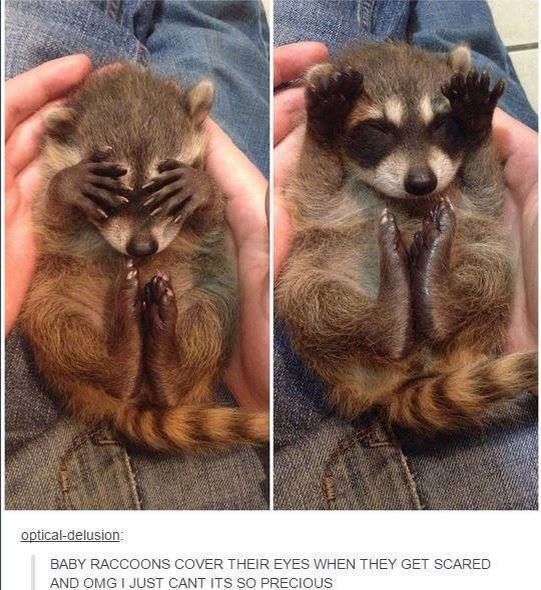 Males do not take any part in the upbringing and feeding of the cubs. On the farm, one male is kept for several females (up to five, it depends on the activity of a particular male). If a female has a sexual desire, she is placed daily in a cage with a male until mating takes place. If the female lets the male in and does not react aggressively to him, then she is left in his cage for a day. After making sure that the mating took place, the female must be returned to her cage and left alone.
Males do not take any part in the upbringing and feeding of the cubs. On the farm, one male is kept for several females (up to five, it depends on the activity of a particular male). If a female has a sexual desire, she is placed daily in a cage with a male until mating takes place. If the female lets the male in and does not react aggressively to him, then she is left in his cage for a day. After making sure that the mating took place, the female must be returned to her cage and left alone.
Feeding in the first decade of pregnancy does not differ from what it was before fertilization. From the 11th, 12th day, in fertilized female raccoons, appetite increases and activity decreases, the animal becomes more calm and lazy. During this period, the proportion of feed of animal origin should be increased in their diet. If it is not possible to give fresh fish and lean meat, then fish and meat and bone meal should be constantly mixed into the porridge, cottage cheese, milk, and eggs should be included in the diet.
Pregnancy in raccoons lasts 63 days. In the second half of this period, the body of the female noticeably rounds off. A day or two before giving birth, the female builds a nest from bedding material (sawdust, straw, leaves) and lines it with fluff plucked from her stomach and sides. Under the action of hormones, their wool is easily plucked in these parts of the body.
Childbirth, as a rule, takes place without complications, and as a result, three to six puppies are born. Cubs are born blind and deaf. Eyes open only by the 18th - 19thth day. For the first month, babies eat only mother's milk. Weaning can begin when they start to leave the nest box and try the food intended for the female.
Young animals grow quickly and by autumn they are almost as large as adult animals. The winter molting of young animals ends by the onset of the first cold snap (October). And at the end of autumn, after the selection of breeding young animals for further reproduction, all animals of fur purpose are slaughtered or sold.

 Provide toys - natural ones are best - acorns, cones, small twigs, bark, limestone chunks, shells, rocks/pebbles, flower seeds, etc., but hard dog toys, cat toys, children's toys are fine too.
Provide toys - natural ones are best - acorns, cones, small twigs, bark, limestone chunks, shells, rocks/pebbles, flower seeds, etc., but hard dog toys, cat toys, children's toys are fine too. 

